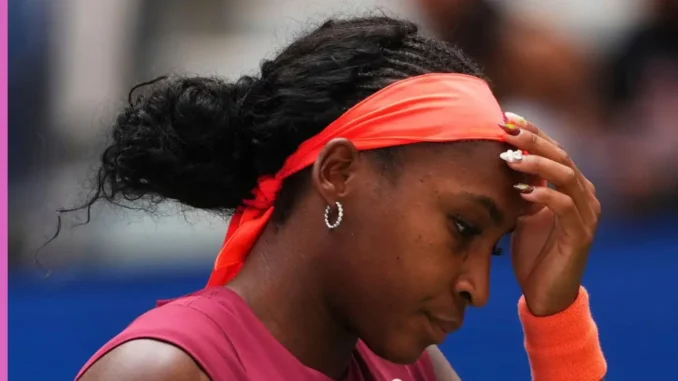
Coco Gauff, the 21-year-old American tennis prodigy, has long been a beacon of hope for the sport, blending raw athleticism with a fierce competitive spirit. Yet, at the 2025 US Open, her fourth-round exit against Naomi Osaka on September 1 sparked intense scrutiny, not of her well-documented serving struggles, but of another critical aspect of her game: her forehand. Former world No. 1 Justine Henin, a seven-time Grand Slam champion, labeled Gauff’s forehand as “catastrophic” during her analysis, pointing to a “lack of evolution” in the young star’s game that raises concerns about her long-term development. This stinging critique, delivered in the wake of Gauff’s 6-3, 6-2 loss to Osaka, underscores a pivotal moment in her career as she navigates technical adjustments under immense pressure.
The match, played in front of 24,000 fans at Arthur Ashe Stadium, was a highly anticipated clash between two Grand Slam titans. Gauff, the No. 3 seed and 2023 US Open champion, entered with momentum after a commanding 6-3, 6-1 victory over Magdalena Frech in the third round. However, Osaka, a four-time major winner, exploited Gauff’s weaknesses with surgical precision. “Osaka did what she had to do by also playing with her experience,” Henin noted. “She didn’t have to force her talent today either, showing solidity and being present.” Osaka’s strategy was clear: relentlessly target Gauff’s forehand, which crumbled under pressure, producing 20 unforced errors compared to just eight from her backhand. Gauff managed only eight winners against 33 unforced errors, a stark contrast to Osaka’s efficient 10 winners and 12 unforced errors.
Gauff’s forehand struggles were evident from the outset. “We felt from the start of the match that Coco Gauff had fallen back into her old ways, not especially in terms of her serve but in terms of her forehand, it was catastrophic,” Henin observed. Unlike her serve, which has been a focal point of criticism and recent coaching changes, Gauff’s forehand has flown under the radar as a liability. The shot, meant to be a cornerstone of any elite player’s arsenal, faltered under Osaka’s aggressive baseline play, leaving Gauff unable to dictate points. This vulnerability was particularly surprising given her recent successes, including a French Open title in June 2025, where she defeated world No. 1 Aryna Sabalenka in a gritty comeback.
The loss capped a challenging tournament for Gauff, who arrived in New York fresh off a coaching shakeup. Just days before the US Open, she parted ways with coach Matt Daly and enlisted biomechanics expert Gavin MacMillan, who had previously revitalized Sabalenka’s serve. The move was a bold attempt to address her serve, which had led the WTA Tour with 311 double faults in 2025. Against Osaka, Gauff showed improvement, recording only five double faults and three aces, with her first serve averaging 104 mph—a nearly 10% increase from her opening match. “I thought that was a good performance from me serving,” Gauff said post-match, finding a silver lining. “I think if I kept the way I was going in Cincinnati to here, I would have been out the first round.”
Yet, the forehand issue overshadowed these gains. Henin’s critique highlighted a broader concern: Gauff’s game, while bolstered by her exceptional athleticism and defensive prowess, lacks the technical refinement needed to consistently compete with the sport’s elite. “What worries me is the lack of evolution in her game,” Henin said, suggesting that Gauff’s progress has stalled despite her youth and achievements. At 21, Gauff has already won 10 WTA singles titles, including two majors, and reached a career-high ranking of No. 2. Her resilience shone through in earlier rounds, where she battled through emotional turmoil, including a panic attack during her second-round win over Donna Vekic. “I just show people what it’s like to be a human, and I have bad days,” she said then, endearing herself to fans with her candor.
Despite the setback, Gauff remains optimistic. “I’m not going to let this crush me,” she vowed after the Osaka loss, her eyes set on a training block before the WTA 1000 in Beijing, where she is the defending champion. Reflecting on her age, she added, “I think today when I walked on the court, I feel like I put so much pressure on myself at my age at 21, and I realized how much the girls on tour are being successful at 25, 26.” This perspective, coupled with her determination to evolve, suggests that Gauff views this defeat as a stepping stone rather than a roadblock.
Osaka’s victory, meanwhile, marked a triumphant return to form, propelling her to her first Grand Slam quarterfinal since 2021. Her performance was a reminder of her pedigree, but for Gauff, the match exposed a critical area for growth. As she prepares for the next chapter of her season, the focus will likely shift to refining her forehand, ensuring it matches the brilliance of her backhand and court coverage. With MacMillan’s expertise and Gauff’s unrelenting drive, the tennis world awaits the next evolution of a star who refuses to be defined by a single defeat.
Leave a Reply